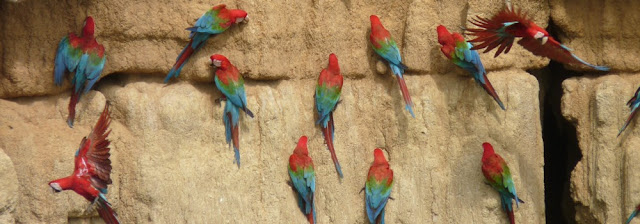Time for another instalment in the ongoing saga of postings on colour in nature. Animals and plants wear red - like black and white that we discussed previously - to be noticed.
 |
| Crimson Chat Epthianura tricolor, Nullarbor Plain, South Australia. |
For plants it is to draw attention to flowers or fruit; for animals it is likely to be to attract mates or intimidate rivals, or perhaps even to warn enemies off. Most reds in nature come from a large class of chemical pigments called carotenoids; these may produce yellow or red (or combinations and variants, such as orange, pink or russet) but because there are so many options I'll stick with red today - and indeed in the next posting too!
Plants, algae and bacteria can produce carotenoids, but animals in general can not. They must eat it from plant sources and transport it internally to deposit it where it is required; this is energetically expensive, but in fact the situation is worse than that for them. Yellow carotenoids are much easier to obtain, and there are many yellow animals of course, but if you really want to stand out red and proud, then you must chemically convert the yellow carotenoids to red, which of course takes even more energy. Being red then is a statement of your fitness and strength - you've got surplus energy to squander on looking gorgeous. It also, I think, helps explain why very few animals are entirely red - that really would be extravagant. On the other hand in some situations the red is made more striking by being in juxtaposition with another colour - the Crimson Chat above for instance. In particular black and red is a very dramatic combination, and I shall devote a whole posting to this very soon.
Not many mammals utilise true red (though some primates have dramatically red faces, or nether regions to advertise sexual receptivity), so most of this post will feature birds and invertebrates.
In some birds the red is featured in bills or legs.
 |
| Red-tailed Tropicbird Phaethon rubricaudaon nest, Lady Elliot Island The red tail-spike is a nice balancing touch. |
 |
| Purple Swamphen Porphyrioporphyrio, Canberra |
 |
| Blackish Oystercatchers Haematopus ater, Isla Chiloe, Chile. The red eyes incidentally are due to pterin, a chemical quite unrelated to carotenoids. |
 |
| Black-necked Stork Ephippiorhynchus asiaticus, Fogg Dam, Northern Territory |
 |
| Malachite Kingfisher Alcedo cristata, Lake Mburo NP, Uganda |
 |
| Coscoroba Swan Coscoroba coscoroba, Puerto Natales, southern Chile. |
Many however have incorporated the red carotenoids into their plumage. It's interesting that the oldest living groups of birds - ratites (emus, kiwis, ostriches etc), gallids (chooks, turkeys, quail, guinea-fowl etc) and ducks, geese and swans - never have red feathers, though they may have red bills or legs like the Coscoroba Swan above. The red feather innovation evolved later.
 |
| Diamond Firetail Stagonopleura guttata, Canberra. Another finch with a brilliant red rump which flashes in flight. |
 |
| Crimson Finch Neochmia phaeton, Darwin, Northern Territory |
 |
| Northern Carmine Bee-eaters Merops nubicus, northern Cameroon. |
+Machuwasi+Lagoon+Manu+1208.jpg) |
| Red-capped Cardinal Paroaria gularis, Manu NP, Peru Actually a tanager.. |
Parrots are different. They use a different class of chemicals, called psittacofulvins, which they can manufacture themselves, so can afford to be more profligate with them.
 |
| Australian King-Parrot Alisterus scapularismale, Canberra. |
 |
| Crimson Rosella Platycercus elegans, Canberra. |
 |
| Red and Green Macaws Ara chloropterus, Blanquillo Clay Lick, Peru. |
For insects the motivations may be similar, though we shouldn't assume that other animals see the same colours that we do.
 |
| Euchromia creusa, Keatings Lagoon, north Queensland. These are warning colours, but a bluff - apparently they are mimicking stinging wasps. |
 | |
| Two red Ugandan butterflies; from Bwindi Impenetrable NP (above) and Budonga Forest (below). Any suggestions welcomed! |
+Fogg+Dam+0706.jpg) |
| Diplacodes haematodes, Fogg Dam, Northern Territory |
And finally, a crab - I have no idea what the advantage of being red is to a crab; if you do, please share!
| Sally Lightfoot Crab Grapsus grapsus, Galapagos |
(Even green or grey crabs and prawns will of course turn red on cooking; this is because in life the red carotenoid Astaxanthin in their shells is masked by the binding protein chains, which the cooking destroys.)
To be continued on Thursday.

